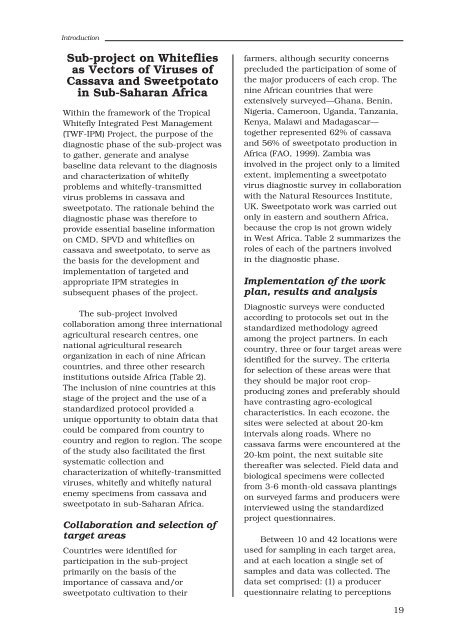Whitefly and whitefly-borne viruses in the tropics : Building a ... - cgiar
Whitefly and whitefly-borne viruses in the tropics : Building a ... - cgiar
Whitefly and whitefly-borne viruses in the tropics : Building a ... - cgiar
Create successful ePaper yourself
Turn your PDF publications into a flip-book with our unique Google optimized e-Paper software.
Introduction<br />
Sub-project on Whiteflies<br />
as Vectors of Viruses of<br />
Cassava <strong>and</strong> Sweetpotato<br />
<strong>in</strong> Sub-Saharan Africa<br />
With<strong>in</strong> <strong>the</strong> framework of <strong>the</strong> Tropical<br />
<strong>Whitefly</strong> Integrated Pest Management<br />
(TWF-IPM) Project, <strong>the</strong> purpose of <strong>the</strong><br />
diagnostic phase of <strong>the</strong> sub-project was<br />
to ga<strong>the</strong>r, generate <strong>and</strong> analyse<br />
basel<strong>in</strong>e data relevant to <strong>the</strong> diagnosis<br />
<strong>and</strong> characterization of <strong>whitefly</strong><br />
problems <strong>and</strong> <strong>whitefly</strong>-transmitted<br />
virus problems <strong>in</strong> cassava <strong>and</strong><br />
sweetpotato. The rationale beh<strong>in</strong>d <strong>the</strong><br />
diagnostic phase was <strong>the</strong>refore to<br />
provide essential basel<strong>in</strong>e <strong>in</strong>formation<br />
on CMD, SPVD <strong>and</strong> whiteflies on<br />
cassava <strong>and</strong> sweetpotato, to serve as<br />
<strong>the</strong> basis for <strong>the</strong> development <strong>and</strong><br />
implementation of targeted <strong>and</strong><br />
appropriate IPM strategies <strong>in</strong><br />
subsequent phases of <strong>the</strong> project.<br />
The sub-project <strong>in</strong>volved<br />
collaboration among three <strong>in</strong>ternational<br />
agricultural research centres, one<br />
national agricultural research<br />
organization <strong>in</strong> each of n<strong>in</strong>e African<br />
countries, <strong>and</strong> three o<strong>the</strong>r research<br />
<strong>in</strong>stitutions outside Africa (Table 2).<br />
The <strong>in</strong>clusion of n<strong>in</strong>e countries at this<br />
stage of <strong>the</strong> project <strong>and</strong> <strong>the</strong> use of a<br />
st<strong>and</strong>ardized protocol provided a<br />
unique opportunity to obta<strong>in</strong> data that<br />
could be compared from country to<br />
country <strong>and</strong> region to region. The scope<br />
of <strong>the</strong> study also facilitated <strong>the</strong> first<br />
systematic collection <strong>and</strong><br />
characterization of <strong>whitefly</strong>-transmitted<br />
<strong>viruses</strong>, <strong>whitefly</strong> <strong>and</strong> <strong>whitefly</strong> natural<br />
enemy specimens from cassava <strong>and</strong><br />
sweetpotato <strong>in</strong> sub-Saharan Africa.<br />
Collaboration <strong>and</strong> selection of<br />
target areas<br />
Countries were identified for<br />
participation <strong>in</strong> <strong>the</strong> sub-project<br />
primarily on <strong>the</strong> basis of <strong>the</strong><br />
importance of cassava <strong>and</strong>/or<br />
sweetpotato cultivation to <strong>the</strong>ir<br />
farmers, although security concerns<br />
precluded <strong>the</strong> participation of some of<br />
<strong>the</strong> major producers of each crop. The<br />
n<strong>in</strong>e African countries that were<br />
extensively surveyed—Ghana, Ben<strong>in</strong>,<br />
Nigeria, Cameroon, Ug<strong>and</strong>a, Tanzania,<br />
Kenya, Malawi <strong>and</strong> Madagascar—<br />
toge<strong>the</strong>r represented 62% of cassava<br />
<strong>and</strong> 56% of sweetpotato production <strong>in</strong><br />
Africa (FAO, 1999). Zambia was<br />
<strong>in</strong>volved <strong>in</strong> <strong>the</strong> project only to a limited<br />
extent, implement<strong>in</strong>g a sweetpotato<br />
virus diagnostic survey <strong>in</strong> collaboration<br />
with <strong>the</strong> Natural Resources Institute,<br />
UK. Sweetpotato work was carried out<br />
only <strong>in</strong> eastern <strong>and</strong> sou<strong>the</strong>rn Africa,<br />
because <strong>the</strong> crop is not grown widely<br />
<strong>in</strong> West Africa. Table 2 summarizes <strong>the</strong><br />
roles of each of <strong>the</strong> partners <strong>in</strong>volved<br />
<strong>in</strong> <strong>the</strong> diagnostic phase.<br />
Implementation of <strong>the</strong> work<br />
plan, results <strong>and</strong> analysis<br />
Diagnostic surveys were conducted<br />
accord<strong>in</strong>g to protocols set out <strong>in</strong> <strong>the</strong><br />
st<strong>and</strong>ardized methodology agreed<br />
among <strong>the</strong> project partners. In each<br />
country, three or four target areas were<br />
identified for <strong>the</strong> survey. The criteria<br />
for selection of <strong>the</strong>se areas were that<br />
<strong>the</strong>y should be major root cropproduc<strong>in</strong>g<br />
zones <strong>and</strong> preferably should<br />
have contrast<strong>in</strong>g agro-ecological<br />
characteristics. In each ecozone, <strong>the</strong><br />
sites were selected at about 20-km<br />
<strong>in</strong>tervals along roads. Where no<br />
cassava farms were encountered at <strong>the</strong><br />
20-km po<strong>in</strong>t, <strong>the</strong> next suitable site<br />
<strong>the</strong>reafter was selected. Field data <strong>and</strong><br />
biological specimens were collected<br />
from 3-6 month-old cassava plant<strong>in</strong>gs<br />
on surveyed farms <strong>and</strong> producers were<br />
<strong>in</strong>terviewed us<strong>in</strong>g <strong>the</strong> st<strong>and</strong>ardized<br />
project questionnaires.<br />
Between 10 <strong>and</strong> 42 locations were<br />
used for sampl<strong>in</strong>g <strong>in</strong> each target area,<br />
<strong>and</strong> at each location a s<strong>in</strong>gle set of<br />
samples <strong>and</strong> data was collected. The<br />
data set comprised: (1) a producer<br />
questionnaire relat<strong>in</strong>g to perceptions<br />
19
















